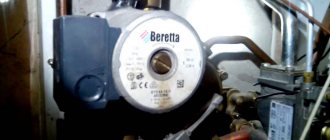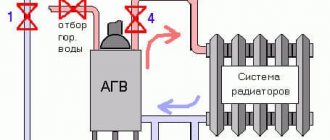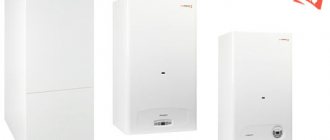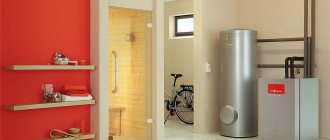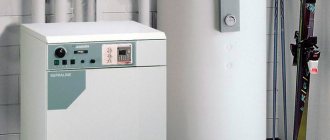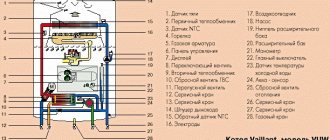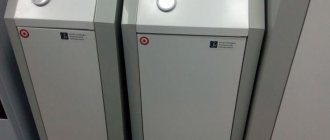How does a heat exchanger work?
A heat exchanger, or radiator, is designed to heat water from the burner. The flow flows through the coil tubes, instantly warming up from the burning fuel. Most often the block is steel or copper. How much does the device weigh? Copper device - from 3 to 3.5 kg. The steel apparatus is much heavier, for this reason it has lower efficiency.
Features of steel product:
- Lower cost compared to copper.
- Due to the plasticity of the material, heating does not harm the surface.
- It is resistant to corrosion.
Copper device:
- It has high efficiency and fast heating.
- Products that contain additional impurities are cheaper.
- Corrosion resistance.
- Light weight if it is pure copper.
Trying to reduce the cost of production, manufacturing companies add impurities to copper. Because of this, the radiator heats up unevenly, which leads to burnout of individual parts. Some people coat the surface with heat-resistant paint, but this brings little results. The service life does not exceed 2-3 years.
Copper is more resistant to corrosion than steel. Most manufacturers do not indicate how much copper is used to produce the product, convincing them that the heat exchanger is made of a thick layer.
To extend the life of the device, install water filters. They soften and clean the liquid from impurities that settle on parts in the form of scale.
How much does it cost to replace a gas boiler radiator? If you take into account the purchase of a new device, delivery and installation, it will be cheaper to repair the heat exchanger.
Materials
Substances transfer heat in different ways. It is necessary to take into account pressure, maximum heating temperature, and corrosion resistance. Heat exchanger materials:
- steel;
- cast iron;
- copper;
- aluminum.
What are the differences?
Steel
The heat exchanger made of steel is the most durable. Tolerates pressure and temperature changes well. Can be repaired and is cheaper than other materials. Disadvantage: severe corrosion. Stainless steel heat exchangers last a long time.
Cast iron
Cast iron models tolerate exposure to water well and are difficult to corrode. They take longer to heat up than steel ones, but stay hot longer. The fragility of the material does not allow impacts.
Carefully. Cast iron does not tolerate sudden changes in temperature. If it is necessary to replenish the system with water, the boiler must be cooled before filling.
To remove scale, the heat exchanger is washed at intervals:
- once a year if running water is used;
- once every 2 years, when using antifreeze;
- once every 4 years, when the coolant is purified water.
Cast iron is the heaviest material.
Copper
Copper transfers heat well, can be soldered, and is lightweight. Almost resistant to corrosion.
Advice. If you install it yourself, you may make a mistake. If there is an electrical circuit in the wall behind the boiler, fistulas will appear in the heat exchanger.
Disadvantages: cost, they burn out quickly.
Aluminum
Lightweight heat exchanger with good thermal characteristics. Does not tolerate scale and requires annual maintenance. Disadvantages: heavy soldering and welding.
Classification of heat exchangers for boilers
Heat exchange elements for a gas boiler can differ significantly in design and use. The following devices are most often used in thermal equipment:
Primary
This category of devices is used to transfer thermal energy directly into the fuel combustion chamber.
Attention ! Primary heat exchangers are operated in very harsh conditions, so they must be made of very high quality materials.
Secondary
The secondary heat exchanger is heated by transferring energy from the coolant to another liquid.
This device is ideal for meeting the need for hot water in the presence of a separate heating circuit.
Bithermal
A bithermic heat exchanger is a modern and practical element of a heating boiler.
This design consists of 2 separate tubes installed one inside the other. Products of this type are used primarily for simultaneous heating of water for heating and domestic needs.
Boiler heat exchanger
At the beginning, let us remember that the heat exchanger is the main element, as such, in the design of a gas boiler. It is through the heat exchanger that thermal energy from the combustible gas is transferred to the coolant (primary heat exchanger) and through the heat exchanger is transferred from the hot coolant to the cold (secondary heat exchanger). It is worth noting that both of the listed heat exchangers are very often replaced by a mixed heat exchanger, which is better known as a bithermic heat exchanger. In the first photo we look at the location of the heat exchanger in a gas boiler with a closed combustion chamber.
The second photo shows the appearance of the heat exchanger.
Material of manufacture
The heat exchanger for the boiler is made from durable materials that conduct heat well, are not prone to corrosion and are sufficiently resistant to pressure. Since the cost of the material also has to be taken into account, the choice is limited.
Steel
A steel heat exchanger is cheaper in price, but less durable.
This is the most affordable material. Steel is very strong, but can be processed well. The price is low. The advantage of this option is resistance to high temperatures. Steel is plastic and does not crack when heated, and does not deform even in areas in contact with the burner.
A steel heat exchanger for a solid fuel or gas boiler is prone to corrosion. Water inside the tubes and combustion products in the boiler chamber have a destructive effect on the material. This affects durability. The steel model weighs a lot, which leads to additional fuel consumption for heating the element itself.
The stainless steel heat exchanger is resistant to corrosion and lasts for at least 50 years.
Cast iron
The material is much more resistant to corrosion than steel, and is not afraid of rust and the action of acid anhydrides. The service life reaches 50 years. However, cast iron is a brittle alloy and can crack under the influence of temperature. To avoid damage, the cast iron tubular heat exchanger must be washed: if ordinary water is used, then once a year; if antifreeze - then once every 2 years; if distilled liquid - once every 4 years.
The weight of a cast iron element is even greater, so more fuel and time have to be spent on heating.
Copper
Copper is a noble metal that is not susceptible to any type of corrosion. It is chemically inert and tolerates pressure well. Copper conducts heat better, so less fuel is required to heat the element itself and the flowing liquid. The weight of the copper model is small, the dimensions are compact with a very developed working surface.
The disadvantage is the high price. Also, the copper heat exchanger is too sensitive to heating to high temperatures. More often found in boilers from foreign manufacturers.
Which material is better
Boiler heat exchangers are made of different metals, the selection of which is made by the manufacturer during the design of the heating source.
Basically, modern devices are equipped with heat exchangers made of steel, cast iron, copper and aluminum. They have different heat transfer coefficients, permissible temperature environments and resistance to corrosion processes. A floor-standing gas boiler with a cast iron heat exchanger is the most economical and durable.
Steel
A stainless steel heating apparatus is technologically the simplest, both in manufacture and in operation. Therefore, it has the most affordable price, which affects the overall cost of the boiler.
Steel has good ductility, so this design in an environment of high-temperature hot gases is less susceptible to temperature deformation.
But at the same time, steel is affected by corrosion, both internally due to dissolved oxygen in the coolant, and externally due to acidic moisture in the flue gases, especially at the time of starting from a cold state. Therefore, these heat exchangers are not durable, have a lot of weight and create low boiler efficiency.
Aluminum
Many Western models are equipped with aluminum heat exchangers, to which experts attribute a great future in household heat and power engineering.
With high ductility, they have thermal conductivity 9 times higher than that of steel. In addition, they have high functionality with low weight.
In such structures, stress zones are not created during a welded joint, like stainless steel devices, and, therefore, there will be no corrosive hazardous areas.
Aluminum components are characterized by strong chemical resistance, which is used in low temperature applications or condensing type boilers.
However, aluminum structures will last less if they use hard tap water; they become clogged with scale almost immediately.
Therefore, initially, manufacturers of boilers with aluminum heating surfaces recommend that owners install water treatment with a water softening system.
Copper
Copper surfaces in boiler heat exchange devices are compact and lightweight, so they are installed on a Navien gas boiler.
Copper is essentially non-corrosive in aggressive acidic environments. Boiler units with similar devices are compact and easy to use. Due to their low inertia, copper devices quickly heat up and cool down.
Copper heat exchangers have more advantages than negative qualities. The copper structure is lightweight, compact, and has a small capacity.
It is not afraid of corrosion processes and requires less gas consumption to heat the coolant. Disadvantages include high cost and unreliability under non-standard cold start-up conditions.
Gas boilers with cast iron heat exchanger
A cast iron boiler heat exchanger is considered the most efficient and durable because it is not subject to corrosion. Moreover, since the material is very fragile, it requires proper use.
Uneven heating of the structure, which occurs at the time of start-up from a cold state or in places of scale formation, leads to the appearance of various cracks in the walls of the structure.
Users of such a device will need to monitor the quality of the feed water, install a cleaning system, and if scale appears for gas boilers with a cast iron heat exchanger, flush the heat exchanger.
Usually it is performed once a year before the start of the heating season. If the feed water is pre-cleaned before being supplied to the boiler, then the flushing frequency is once every 4 years.
Correct operation
The heat exchanger is washed depending on the water hardness.
Transportation, installation and operation of the heat exchanger device are described in detail in the instructions:
- The heat exchanger is placed in the apparatus so that it has easy access for inspection and repair.
- Start-up is performed at stable pressure and temperature. Do not increase the temperature faster than 10 degrees per minute or increase the pressure more than 10 bar per hour.
- When filled with water, the air valves and valves behind the heat exchanger remain open. After the pump starts, they are closed. In this way, stable pressure is achieved.
- You need to change the heating parameters smoothly. The slower this happens, the longer the seals and the heat exchanger itself will last.
- The device needs to be cleaned periodically. The plate is cleaned directly in the frame, then the plates are removed and washed. Another method is possible: first removing and then cleaning the plates. It is not recommended to clean shell-and-tube machines. In case of complex blockages, the technician installs a plug.
- Before restarting, check the condition of all gaskets. Pressure and temperature are set as at 1st start.
To avoid salt deposits, a filter is placed on the water pipe in front of the boiler entrance.
Bithermic heat exchanger (combined)
It has several popular names: “pipe in pipe”, combined. This is due to the fact that the devices for the OB and DHW circuits are combined. The outer pipe heats water for heating, and the inner pipe heats water for hot water.
A bithermal heat exchanger has a number of advantages and disadvantages. Let's look at the pros first.
- High efficiency and fast water heating. The water is heated in such a boiler from the burner flame, and this allows you to reduce costs for electricity and gas
- Simplified design. For a bithermal heat exchanger there is no need for a three-code valve and a secondary heat exchanger. Due to the absence of a large number of moving parts, the likelihood of a malfunction is much less than with a separate unit
- Affordable price. The price of a bithermic heat exchanger is 10-15% lower than that of a separate one. This is due to the same simplified design and the absence of complex elements
Disadvantages of a bithermal heat exchanger
The main disadvantage, which sellers often talk about, is the increased requirement for water quality. It is not recommended to install a device with a bithermal heat exchanger if the water is saturated with salts. At high temperatures, salt deposition occurs more intensely, which can lead to failure of the unit.
But is this really so? If you purchase boilers with a bithermic heat exchanger from reliable manufacturers and do not skimp on quality, the device will operate for a fairly long period. What about scale?
There is no need to use the system in the “boiling” mode at the bottom; additionally, you can install filters and water softening systems.
Reasons why the heat exchanger is clogged:
- Manufacturing defects.
- Poor quality installation.
Remember, if the circuit is clogged, the subscribers are most often to blame. They don’t want to look for a leak and don’t turn to specialists. And despite the brand, the boiler manufacturer will have the same outcome.
How to avoid the problem?
In order to prevent a deplorable situation, it is worth doing annual maintenance of the boiler, repairing it in a timely manner and calling a specialist.
“The water is hot” or can you get scalded?
Another equally important disadvantage of a bithermic heat exchanger is too hot water. This happens when the tap is opened while the boiler is operating at maximum mode. Many people say that you can scald yourself with such water, but what in reality? The water temperature does not exceed the established value, which is 55 degrees. During the heating season, the water will be exactly like this when you open the tap, and then the temperature will be reduced to the optimum.
Conclusion about the bithermic heat exchanger: this is an ideal affordable option for private use.
Primary heat exchanger repair
The exchanger deteriorates due to poor quality coolant or the materials from which it is made, as well as other factors. Pressure, high temperatures and their differences lead to cracks, which is why the element begins to work less powerfully and breaks down over time. The life of the heat exchanger can be extended if purified water is supplied and the boiler is not overloaded.
We recommend: Pellet stove: automatic pellet stove, pellet boiler with water circuit, long-burning heating stove
It will be more difficult to eliminate cracks than clogs. The heat exchanger is soldered for this purpose. Select solder from the same material as the unit itself. Boiler heat exchangers are usually made of copper, less often cast iron or steel. Aluminum, silicon, manganese, nickel and zinc are added to the composition.
Leaks on the primary heat exchanger can occur due to exposure to flames, water hammer, and in some cases they are caused by corrosion
Additional solder requirements:
- melting point not lower than 700 °C;
- sufficient viscosity;
- fluidity is the same as that of a heat exchanger.
Copper-zinc solders are considered one of the best. They are used for soldering most non-ferrous metals with a higher melting point than the support material itself. Solders with inclusions of silicon or tin - up to half a percent - are safer for the human body.
It is better to avoid copper-phosphorus materials, and if exchangers are soldered with them, do so without any load such as shock or vibration. Well-chosen solder is half the battle.
Heat exchangers are soldered with gas burners and blowtorches. Before soldering, the desired area is cleaned with fine-grained sandpaper and wiped with a rag with a solvent, and then heated. The area is heated with a hairdryer or a weak burner/soldering iron. At this moment, the main thing is to get into the temperature corridor and take into account subsequent cooling. Barely noticeable damage is found by small greenish spots.
Before heating, the water is drained, and its remains are removed with a compressor or blown out through a flexible hose. The hose is fixed by thread if it has a union nut and the design features allow this. If you leave water, it will take away part of the thermal energy.
Solder spools: At high temperatures, the material wets the base and spreads across it, gets into the smallest gaps and stretches, resulting in an intermediate layer of base and solder combination
Solder is preferred in the form of a wire or rod: when soldering, the molten end will be well immersed in the flux, which will stick to it. If the wire lays on the exchanger itself too intermittently or loosely, the preheating was weak. After work, the soldering area is sometimes coated with heat-resistant paint for better insulation.
Over the next two weeks, the soldered area is checked daily for integrity. At the first detected leak, you should contact a specialist. If it appears in the first fortnight, it means the soldering was of poor quality.
The flux is suitable for universal use, as well as gel soldering flux. Avoid rosin, unusual options like aspirin and others.
Wall-mounted gas boilers with separate heat exchangers
When choosing wall-mounted gas boilers, most consumers prefer models with separate heat exchangers. They are characterized by high reliability and long service life. There are actually two heat exchangers inside them - one is responsible for heating the coolant for heating needs, the second ensures the preparation of hot water. The main advantages of gas boilers with separate heat exchangers:
- Easy to maintain and clean heat exchangers;
- Ease of repair work;
- Low intensity of salt deposition;
- No overheating of water in the DHW circuit.
Despite the complex internal structure, the operating principle of these boilers is simple. In heating mode, the main heat exchanger is responsible for heating the coolant. When a hot water tap is opened, the three-way valve is activated and the heating circuit is turned off, part of the coolant is sent to the second heat exchanger, where the water is heated for the hot water supply circuit. Primary heat exchangers in wall-mounted gas boilers are most often made of copper or steel, secondary heat exchangers are made of steel. They are easy to repair and change independently of each other, are less clogged with deposits, and are easy to wash during maintenance.
Wall-mounted gas boilers with separate heat exchangers are presented in the following modifications:
- With open and closed combustion chambers;
- With built-in boilers;
- Low and high power.
Boilers with open combustion chambers are simpler; they are installed in buildings and apartments equipped with a classic chimney. They are cheaper and less noisy, but require rooms with access to oxygen. Models with closed combustion chambers are installed in any premises and connected to coaxial chimneys. All wall-mounted gas boilers with two separate heat exchangers are double-circuit. In some models there are boilers for the preparation and storage of hot water - they are characterized by increased productivity of the DHW circuit. As for the thermal power, it is selected based on the area and volume of the heated premises, taking into account the reserve.
You can buy wall-mounted gas boilers with separate heat exchangers from leading Russian and foreign manufacturers in the Teplodvor online store. We will delight customers with economical and functional models, low prices for heating equipment and prompt delivery throughout Moscow and Russia. We also have all the necessary equipment for installing hot water supply and heating systems.
Repair of secondary heat exchanger
Secondary heaters often clog, especially models with narrow channels. Without cleaning, they break down over time and finally fail. A layer of scale inside the unit reduces heat transfer, causing the boiler to consume more gas.
Salt deposits, scale and rust form the bulk of the contamination: in addition to the secondary heat exchanger, it doesn’t hurt to also check the heating and hot water circuits
Problems with heat exchangers will be indicated by codes on the boiler display. There is an action plan for this case.
Let's take a closer look at the problem with the secondary heater:
- We take out the secondary heat exchanger.
- We look at the joints, internal and external threads. After the last cleaning, their condition may have worsened. This happens due to aggressive acids. We replace worn out removable elements.
- We check the integrity. The heat exchanger could experience a water hammer. Only a specialist will find a very small fistula (hole).
- We better inspect the exchanger, and for this we call a specialist. We replace a severely damaged unit.
- Even at the very beginning, contamination can be found. We look for plaque visually in the inlet openings. We blow air into the part and also focus on the sound. We clean it if the exchanger is clogged. Pieces of scale may fall out of it even after a slight knock.
- You need to choose 1 of 3 cleaning options: home remedies like detergents and solutions with citric acid, special mixtures, or professional cleaning.
First of all, rinse the exchanger with a stream of water from a cold tap. Then pour citric acid into the device and place it in a bucket of water. Afterwards, take out the heat exchanger and pour water into it to check the permeability.
If it comes in slowly or does not move, then prepare a saturated solution of vinegar in water and pour it there. Then rinse with hot water and blow off. If possible, use an air pump. Do several cycles with vinegar.
Among the arguments for professional cleaning, it is worth noting the inconvenience of the design for cleaning, difficulties in assessing contamination, and the risk of damage due to independent mechanical action
If the steps described do not help, try special cleaning solutions: cleaning gel or low-percentage adipic acid solution. If this method does not work, then call a specialist or order professional cleaning.
Types of heat exchangers for gas boilers
Gas boilers for individual heating may also differ according to such criteria as the number of circuits. Thus, boilers can be single-circuit or double-circuit. Using a double-circuit boiler, you can organize not only a home heating system, but also a hot water supply system. Using single-circuit boilers, you can only organize a heating system. Gas boilers with two circuits may differ in the type of heat exchanger. How a gas heating boiler works depends on this. This component of a gas boiler can be bithermic, separate or with a built-in coil.
A bithermic heat exchanger is usually made of a material such as copper, and its design looks like a “pipe within a pipe”. The heating circuit coolant moves through the outer pipe, while running water, which is necessary for the hot water circuit, circulates through the inner pipe. If we compare these best gas heating boilers with boilers with a separate heat exchanger, they are included in a lower price category and stand out for their reliability. This is due to the fact that they lack various additional hydraulic components, such as a secondary heat exchanger and a three-way valve.
Bithermic heat exchanger
Bithermal boilers also have their disadvantages:
- Manufacturers advise against using such boilers in areas where the water is too hard and contains salts. Due to the temperature difference in the heating circuits and in the hot water supply, salt deposition occurs more intensively.
- When you open a hot water tap, about 150 ml of water with a temperature of about 70-80 degrees will initially flow out, after which the water temperature will be the most optimal for you.
Rating of gas heating boilers with a separate type heat exchanger - such boilers are the most popular.
The design of such boilers includes several heat exchangers: a primary heat exchanger made of copper, intended for the heating circuit, and a stainless steel plate-type heat exchanger, intended for the hot water supply circuit.
Such equipment is not cheap, since it contains a secondary heat exchanger and a three-way valve. The advantages of such boilers include reliability during operation in areas where water is characterized by increased hardness.
Domestic gas heating boilers for industrial use
Heat exchanger of separate type of double-circuit boiler
Heat exchanger with a built-in coil - such a heat exchanger can only be found in double-circuit floor-standing boilers of a non-volatile type. Hot water is heated in boilers of this type indirectly, due to the temperature of the coolant in the heating system circuit. The disadvantage of such a boiler is that it is impossible to regulate the temperature of the hot water. Another disadvantage is the inconvenience of operation, since to heat hot water in the summer it is necessary to use a heating circuit. This type of heat exchanger is usually made of materials such as steel, copper or stainless steel. The most popular heat exchangers of this type are those in which the built-in coil is made of steel and has a thickness of 3 to 4 mm. Heat exchangers with a built-in coil are characterized by a fairly long service life.
Heat exchanger with built-in coil
Disturbances in the operation of the column and their elimination
If your water heater suddenly leaks, sometimes the reason is worn out gaskets. When removing the casing, it becomes clear whether this assumption was justified. Having found a fistula in the heat exchanger, many consumers are interested in how to replace the problematic part. But the difficulty is that the price of spare parts reaches 30% of the price for a completely new heater.
It is much more practical to solder a mechanical defect using a soldering iron. Solder melts at about 200 degrees. The exact value is determined by the brand of the specific part. Even if the water boils for a long time, it will not damage the integrity of the “patch.” This solution is equally relevant for Russian and foreign speakers. After all, the risk of breakdown is present everywhere, only the service life differs, but defects will still appear in any model.
Criterias of choice
The first difference between gas boilers is that, as a complete review of gas heating boilers shows, there are boilers with an open combustion chamber, and others with a closed combustion chamber. In boilers with an open combustion chamber, combustion products are thrown into the chimney due to the draft that is present in it. Oxygen, without which the combustion process is impossible, is taken from the room in which the boiler is located. Before choosing a gas heating boiler, you should consider that a boiler with an open chamber can only be installed in a room where there is good ventilation.
Gas heating boilers for apartments with a closed combustion chamber take in air through a coaxial chimney. Combustion products are also released through this chimney. Such a chimney is laid from the boiler to the street through the wall.
The coaxial chimney is a “pipe-in-pipe” type structure. Fresh air enters through the outer chimney pipe, and exhaust gases are discharged through the inner pipe. When choosing a gas heating boiler, you should know that in the case of boilers with a closed combustion chamber, air comes from the street, so such a boiler can be installed even in an unventilated room.
Coaxial chimney
Based on such criteria as exhaust gas removal, models of gas heating boilers can be divided into the following types: parapet, chimney and turbocharged.
- A parapet boiler is a unit with a closed combustion chamber in which exhaust gases are released naturally.
- A chimney boiler is a unit with an open combustion chamber.
- A turbocharged boiler is a boiler with a closed combustion chamber.
The release of exhaust gases in such boilers occurs forcibly. To exhaust exhaust gases, turbocharged gas heating boilers are equipped with a built-in fan.
Reasons for heat exchanger failure
The period of operation is determined primarily by how the water in the city water supply is disinfected. In Russia, either pure chlorine or chlorine dioxide is used. When the water flowing through the copper tube heats up, it causes a violent chemical reaction. Copper chloride is inferior to pure metal in strength, and therefore fistulas appear quite quickly. The luckiest people are residents of cities where tap water is ozonated.
We recommend: Electric heaters for heating with minimal energy consumption
But there are still very few such settlements. The high cost of the modern solution does not allow us to count on the rapid spread of ozonation. Moreover, now manufacturers have begun to save in every possible way. And if previously troubles happened quite rarely with thick tubes of heat exchangers, now thin, low-quality copper is used everywhere. The service life of products has significantly decreased.
Pros and cons of cast iron heat exchangers
Boilers with a cast iron heat exchanger have the following advantages :
- do not corrode like steel;
- cast iron distributes heat evenly;
- have excellent thermal characteristics;
- resistant to aggressive environments and acids;
- withstand high temperatures;
- Service life with careful handling is up to 40 years.
Floor-standing, non-volatile single-circuit boilers and their advantages Find out which floor-standing gas boilers are considered the most reliable
Cast iron heat exchangers also have disadvantages:
- heavy weight, which is inconvenient for transportation;
- they are afraid of strong temperature changes, for example, if water gets on a hot surface, cast iron can crack;
- a gas boiler with such a heat exchanger should be moved very carefully, since the material is quite fragile and can crack upon impact.
Note! Only floor-standing gas boilers are equipped with cast-iron heat exchangers.
Cast iron heat exchangers consist of separate sections, so if one of them breaks, it will not be difficult to replace it. However, despite a lot of positive qualities, units with steel contours are still more popular. This is explained by the fact that their cost is 1.5 times less than cast iron ones. Although, with long-term use, the high price of boilers with cast iron heat exchangers is completely justified.
The process of replacing a heat exchanger with your own hands
To save money, many users decide to replace the heat exchanger in a gas boiler with their own hands. It’s worth noting right away that you shouldn’t try to solve the problem by soldering the hole that appears - this will extend the life of the heat exchanger by no more than 2-3 months. It is better to call a service center specialist or purchase a new circuit and perform the replacement yourself. The sequence of actions when carrying out repairs with your own hands is as follows:
- turn off the gas;
- disconnect the unit from electricity;
- disconnect the boiler from the water lines and prepare a bucket in case the remaining water leaks out;
- use a screwdriver to remove the unit cover;
- check according to the diagram in the instructions where the heat exchanger is located;
- disconnect the circuit and take it to the store to buy a new one, or immediately screw on a working element if available;
- connect the gas boiler to all previously disconnected communications;
- let in coolant to check the tightness of the system;
- If everything is normal, close the boiler body and screw in the removed bolts.
Replacing the circuit in a gas boiler with your own hands is quite possible, but it requires some accuracy and a clear sequence. If this manipulation seems too complicated, call a specialist - he will save you the unnecessary hassle of finding a suitable part, do everything quickly and provide a guarantee for his work.
Recommendations when choosing a boiler
Choosing gas boilers is not an easy task, so you should focus on several recommendations. What types of gas heating boilers are there is a question that worries everyone, but the most important difference is in the purpose.
Single-circuit boiler
Single-circuit wall-mounted gas boilers depend on the availability of a source of electricity, as they are equipped with electronic controls. All information is displayed on the liquid crystal or LCD display of the device. Such gas heating boilers will significantly save gas consumption, as they can be equipped with temperature sensors.
It is recommended to use additional equipment in the form of voltage stabilizers or an uninterruptible power supply to operate such boilers, since in our country you can often see how unstable the electricity supply can be.
Floor-standing single-circuit modern gas heating boilers are in greater demand and popularity than wall-mounted devices. This can be explained by the fact that the first type of boiler is cheaper, and it does not depend on the source of electricity. There is also no need to spend money on additional equipment that will ensure a stable supply of electricity.
Single-circuit floor-standing boiler
Before choosing a gas heating boiler, you need to take into account that floor-standing gas boilers are more used for heating systems with natural as well as forced circulation. A constantly burning wick ignites the main burner, and the piezo element ignites the wick. If the wick goes out or there is a leak of exhaust gases or natural gas, the safety group with which the floor-standing boiler is equipped will stop the gas supply to the boiler. If we compare gas heating boilers, we can note that a single-circuit floor-standing boiler from domestic manufacturers is an inexpensive and reliable device.
Double-circuit boiler
A floor-standing double-circuit boiler from domestic manufacturers is quite significantly inferior to boilers from foreign manufacturers:
- It is impossible to adjust the temperature of hot water as required;
- In floor-standing boilers, the hot water performance is significantly inferior to wall-mounted models.
The DHW circuit is a circuit that produces heating indirectly. In order to get hot water, you will need to maintain the temperature in the heating circuit all the time, even in summer. In order not to heat the entire heating system, you can install a tap on the boiler return line that can shut off the movement of the coolant, so only the water that is in the boiler heat exchanger will be heated.
Double-circuit wall-mounted boiler
Gas heating boilers of low power or large wall-mounted type with two circuits are also dependent on the source of electricity. Using the monitor equipped with the device, the user can see all the necessary information: the temperature of the DHW circuit or heating circuit. As a comparison of gas heating boilers shows, many modern boilers are equipped with electronics that allow you to set a certain temperature for a specific time interval, for example, one week. In order to reduce the amount of gas consumed, wall-mounted gas boilers with two circuits can be supplemented with various temperature sensors, both external and internal.
Double-circuit inexpensive gas heating boilers can only be installed in a closed-type heating system.
Since they are equipped with a circulation pump, the coolant will circulate forcibly. As the water heats up, it will expand, which means some excess will be created. They will be taken up by a built-in expansion tank. Such a tank can have a volume of about 5 liters or more. It all depends on the design features of the boiler and its power indicators. If you have an older type heating system, for example, a gravity heating system, then most likely you will need to purchase another expansion tank.
Gas heating boilers
Read more in the article about double-circuit gas boilers
Heating system expansion tank
To determine what capacity the expansion tank should be, you can use the following formula:
Z = R/10;
R – heating system capacity;
Z – capacity of the expansion tank.
Wall-mounted mini gas heating boilers with two circuits are usually produced with power parameters of at least 18 kW. Most often, such boilers have a rated power of 20, 24, 28 and 35 kW. Boilers with minimum power can heat about 9 liters of water per minute.
In addition, which gas heating boiler to choose, now the question arises, what water flow will be the most optimal. One consumer will require a water flow of 9 to 11 liters per minute. For two consumers using hot water at the same time, 12 to 14 liters per minute will be required. For three consumers and above, a pressure of about 15 liters per minute will be required.
How to clean the heat exchanger of a gas boiler
To clean the heat exchanger from scale, mechanical, chemical and magnetic cleaning methods are used. The first option is performed using a cleaning rod and scraper.
Tools can be manual or electric. The chemical option involves the use of crustacean chemicals that can loosen and dissolve contaminants.
To flush the heat exchanger using this method, use a special pump circuit and a flushing agent specified by the manufacturer, for example, for a Baxi gas boiler.
Algorithm for cleaning the heat exchanger from scale:
- Turn off the boiler.
- Prepare liquid for flushing heat exchangers of gas boilers according to the manufacturer’s recipe.
- After complete cooling, utility networks are disconnected from it and the water is drained.
- Remove the tie rods, move the pressure plate aside and then carefully remove each plate one by one. The work is carried out with gloves so as not to injure your hands.
- When working with acid, change gloves to rubber ones.
- Prepare a container for cleaning the plates so that they are completely covered with the working solution.
- The plates are immersed in the composition for 1 hour, after which the remaining deposits are removed under tap water using a brush.
- Assembly of the cleaned structure is carried out in the reverse order.
After washing the heat exchanger, check the tightness of the boiler under the operating pressure of the coolant. All utilities, gas and electricity are connected and the equipment is started for the first time after flushing.
If a leak is detected, it is necessary to tighten the nuts or install a new gasket on the heat exchanger.
Boiler heat exchanger material
The most common materials for the manufacture of heat exchangers for gas boilers are steel and cast iron in the case of floor-standing models, and copper and aluminum alloy in the case of wall-mounted gas boilers.
There is no definite answer that one material is bad in all respects, and the other is good. It all depends on the quality of the metal, its thickness, production culture, accuracy during loading and unloading operations and some other parameters.
It is a common belief that a cast iron heat exchanger is always better than a steel one. This is not entirely correct. Agree, both cast iron and steel come in different qualities. At the same time, heat exchangers from different manufacturers have different thicknesses.
Cast iron is less susceptible to corrosion; a cast iron heat exchanger is usually made thicker, which can have a positive effect on its service life. At the same time, a cast iron heat exchanger also has disadvantages. It is more fragile, and, therefore, there is a risk of microcracks forming during transportation and loading and unloading. In addition, during the operation of cast iron boilers when using hard water, due to the design features of cast iron heat exchangers and the properties of cast iron itself, over time they are destroyed as a result of local overheating. If we talk about steel boilers, they are lighter and are not very susceptible to shock during transportation. At the same time, if used incorrectly, the steel heat exchanger can corrode. But it is not very difficult to create normal operating conditions for a steel boiler. It is important that the temperature in the boiler does not fall below the “dew point” temperature. A good designer will always be able to create a system that will maximize the service life of the boiler.
Boiler heat exchanger material
340 279 Material of boiler heat exchangers Material of boiler heat exchangers Material of boiler heat exchangers 220 277 Material of boiler heat exchangers Material of boiler heat exchangers Material of boiler heat exchangers
830 1245 Boiler heat exchanger material Boiler heat exchanger material
For traditional wall-mounted gas boilers, copper heat exchangers that are fairly lightweight and resistant to corrosion are often used.
Condensing boilers have their own specifics and therefore they use heat exchangers made of aluminum alloy.
TIC "TEKHNODOM" offers you gas boilers
with cast iron heat exchanger Lamborghini, Buderus, Protherm
with steel heat exchanger Zhukovsky, Baxi
with copper heat exchanger Buderus, Vaillant
with aluminum alloy heat exchanger Baxi, Navien
How to extend the life of a heat exchanger?
In order for the heat exchanger to work as long as possible, a number of specific recommendations should be followed:
- Install a filter on the tap water supply - this will prevent the accumulation of lime deposits inside the circuit and minimize the effects of corrosion.
- Clean the heat exchanger in a timely manner, especially for units that are not equipped with water filters. The part must be cleaned regularly once every 2 years, if there is filtration - once every 4-5 years.
- Do not use the maximum operating mode of the burner all the time.
When choosing a gas boiler for a house or apartment, take into account the fact that heat exchangers made of cast iron or copper are considered the most durable.
Cast iron heat exchanger
The heat exchanger is made of cast iron and is not subject to corrosion, but requires careful maintenance and careful operation. These features stem from the properties of cast iron and the main thing is the fragility of cast iron. Uneven heating, which most often occurs due to scale, leads to cracks in the heat exchanger.
Information: Flushing the coolant is a mandatory and basic element of the technical operation of a gas boiler. The coolant is being flushed
- Once a year, if used as a coolant - running water (not recommended),
- Once every 2 years, if used - antifreeze,
- Once every 4 years, if purified water is used.
Malfunctions, repairs
Gas heaters have light indication. It is intended to notify of malfunctions. Each manufacturer creates its own character code contained in the passport. If you don’t have a passport, you can download it on the Internet. Malfunctions can be divided into two categories:
- those that can be eliminated on your own;
- requiring specialist intervention.
What you can fix yourself is not specified in the passport. Common heat exchanger failures:
- depressurization;
- blockage
Elimination of leaks is carried out with a soldering iron, welding, depending on the metal. The second malfunction occurs due to poor-quality coolant, scale. Eliminated by washing. To remove scale, you can use phosphoric acid or citric acid. The first one is more effective. How to do it is shown in the video:
Sometimes there is a manufacturing defect, but more often the malfunction occurs due to improper use of the devices. If you strictly follow the manufacturer's recommendations, the product will last a long time and with high quality. Boiler repair:
Washing methods
There are simple variations that practically do not involve any expenses, there are budget ones with minimal investments, and professional ones - they cost much more, but are highly effective.
How to flush the secondary heat exchanger of a gas boiler in one way or another? And when is it logical to use them. It all depends on the volume of deposits.
In the simplest situation, mechanical cleaning is sufficient. The outside of the VT ribs are cleaned. The work uses any hard brush, spatula, scraper or cable. It is very important here not to damage the plates.
The second method is washing with a special composition. In practice, it is combined with the first method and follows immediately after it.
The part is placed in a container with an acid mixture. Type of acid used: hydrochloric or citric. Suitable proportions: 100 grams per 10 liters. Water.
Acids can be replaced with any anti-scale preparations. After 30-40 minutes, the VT is removed from the container. The remaining scale is carefully wiped off.
At the same time, the coil is also cleaned. A special steel brush is used here.
The third method is chemical. More aggressive substances are pumped through the VT using a special pump. It attaches to the pipes of the part.
We recommend: What is a bithermal heat exchanger and its pros and cons
Suitable tools for the job are shown in this table:
| Facilities | Description | Proportion to water: grams: liter | Water temperature | Product price (RUB) |
| Lemon acid | Popular folk remedy | 100 : 10-12 | 50-70°C | 50 – 1 sachet. |
| Thermagent Active | A versatile liquid with a powerful effect | 1 : 9 | 40-50°C | 1500 – 10 kg canister. |
| STEELTEX Cooper | One of the most effective preparations, but suitable for working with light alloy parts | 1:6 to 1:10 | 40-60°C | 1300 – 5 kg capacity |
| Detex | Concentrate with effective biological substances. Excellent cleaning of steel, cast iron and copper parts | 200-500 :10 | 40-50°C | 4900 – 10 l canister. |
| Hydrochloric acid | Effectively removes heavy scale | 100 : 10 | 50-70°C | 50 – 1 kg |
A hose is placed in the container with the mixture almost to the very bottom, one side connected to the VT, and the other to the pump. This creates the necessary circulation. The procedure lasts 30-40 minutes. Then the part is thoroughly washed with plain water.
The fourth method does not involve extracting the component. This is a hydrodynamic flushing of the secondary heat exchanger of a gas boiler. But it is carried out only by professionals. This requires special technology and compliance with safety criteria.
Its principle is to run a special composition through the boiler system under powerful pressure (1.5-2 bar). The work is done by a booster. Abrasive elements are added to the cleaning liquid.
This is the most effective method, gently removing all deposits and cleaning the part to a commercial appearance.
If you doubt the success of self-cleaning, you can order this service. All operations are carried out within a day. Their price tag is determined by the following factors:
- region,
- power and boiler modification,
- company's markup,
- the equipment and chemicals used.
In Moscow and the central region, clients pay about 3,500-9,000 for services. In St. Petersburg - 3,000 - 7,000 rubles. In other regions: 1700 – 4500 rubles.
Distinctive features
Floor-standing cast iron gas boilers, unlike steel units, have a prefabricated sectional design. It is worth noting that the units are assembled only by hand.
Features of cast iron heat exchangers:
- Cast iron, once heated, retains and releases thermal energy for a very long time. This material also resists aggressive environments and acids well.
- Since the design of the cast iron heat exchanger is prefabricated and it consists of separate sections, in case of any damage, all parts can be replaced individually.
- The heat exchanger is not afraid of high temperatures and can withstand heating up to 300°C.
- The service life is quite long - 25 years or more.
Cast iron heat exchangers can be found in both domestic and industrial boilers.
You can read about the types of heat exchangers for gas boilers here.
What is better to pour into “cast iron” – water or antifreeze?
The characteristics of a cast iron heat exchanger allow the use of water and antifreeze as a coolant. Cast iron does not react with antifreeze liquid. The heat exchanger sections are twisted hermetically, which eliminates leaks after filling with antifreeze.
When choosing a coolant, focus on the following characteristics:
- Heating time - antifreeze has a higher density than water. Therefore, it takes longer to warm up than water. If we take into account the time required to heat the heat exchanger itself, before heat is supplied to the room, it will take from 10 minutes to half an hour.
- Heat dissipation - antifreeze heats up for a long time, but then remains hot for a long time. At the same time, the cost of heating the coolant is greater than that required to heat water.
A cast iron heat exchanger working with antifreeze in the heating system is effective only in cases where it is planned to heat the room not constantly, but from time to time. In other cases, it is more advisable to fill the system with ordinary or distilled water.
Heat exchanger
The main attention should be paid to the heat exchanger, which can be made of different materials, because the service life of the equipment depends on this. For example, wall-mounted gas boilers with a cast iron heat exchanger will last for many years. However, it is difficult to install such units due to their heavy weight.
Devices with a copper heat exchanger weigh much lighter, and their price is much lower. A steel heat exchanger has high heat transfer, but is susceptible to corrosion.
Booster Summary
This is very rare and expensive equipment. If you intend to buy it, then you will expect expenses in the range of 40,000 - 90,000 rubles. And for everyday tasks this is a rather unprofitable solution.
The booster itself is a container with a built-in pump that provides a change in the flow vector. Because of this, the efficiency of washing increases significantly. The devices are resistant to any reagents.
The most popular models are presented below:
| Booster | A country | Productivity (liters per hour) | Tank volume (l) | Working pressure (bar) | Price tag (RUB) |
| PIPAL PUMP ELIMINATE 20 V4V | Italy | 2600 | 18 | 1 | 38 000 |
| BWT Cillit SEK 28 | Germany | 2400 | 20 | 1,5 | 57 000 |
| TM Aquamax | Italy | 5000 | 30 | 1,2 | 53 500 |
Smoke removal
There are two types of smoke removal methods: natural and forced. Which one is better to use depends on several factors: the condition of the chimney, room ventilation, etc.
Natural
Often, a wall-mounted gas boiler is installed with a natural chimney. In this case, the smoke is exhausted through a vertical pipe passing through the roof. The only condition for this method is the presence of good ventilation in the room where the water heater is installed.
Forced
If a private house does not have a chimney pipe or its condition leaves much to be desired, it is recommended to purchase a device with a built-in fan. Then the smoke can be removed through a hole in the wall, although such equipment will cost a little more.
Coaxial
Modern wall-mounted gas boilers are equipped with a coaxial smoke exhaust system. This is a special chimney in which one pipe is located inside another. The smoke is removed through the inner pipe, and air is supplied to the burner through the outer pipe. The advantage of such a system is that the pipe can be located both in a vertical and horizontal plane.
Actions for models of different brands
In general, there are few differences here. They relate to the disassembly of equipment and the use of one or another cleaning method. Available specifics regarding models of different brands are reflected below:
The first one is Navien. Any substances other than hydrochloric acid solution are suitable for washing VT. It greatly damages and even etches surfaces.
The second is Ariston. When flushing them, the maximum permissible pressure should be used, especially when working with a booster. In general, any drugs are suitable for the procedure. For light stains, acetic acid is recommended.
The third one is Baxi. There are no special criteria. This is a popular brand with service points in many cities. This way the service is cheaper.
The fourth is Vaillant. Here, as a rule, a copper VT is installed. For light contamination, use citric or acetic acid. In more severe cases, use the drug Aquamax.
Fifth - Beretta. In mild situations - hydrochloric acid. In extreme cases, the drugs Descalex and Remokal, as well as the Hydroflow cleaning system, effectively help.
Sixth – Ferroli. In many cases, adding hydrochloric acid helps. A more effective method: the same acid is heated in a booster to a temperature of 35-40 degrees. The cleansing process starts. This is a budget option. The more expensive one is associated with the use of special drugs.
Seventh - Junkers. Simple stains can be removed with hydrochloric or citric acid, or any anti-scale agent. In complex cases, pumping of the cleaning composition, heated to 50 degrees, with a circulation pump is required.
Eighth - Neva Lux. A citric acid solution is prepared according to the correct procedure, and the extracted VT is placed in it for 10-20 minutes. Then rinses thoroughly. In many cases, this method brings the desired effect. Difficult blockages are removed using a hydrochemical method using a booster.
The ninth is Viessmann Vitopend 100. For simple and complex solutions, any product that does not contain chlorides is suitable. Antox 75 E is particularly effective.
Tenth - Fondital Tahiti. For simple stains, any standard solutions are used (acids, descaling agents, special preparations). If standard solutions do not help, change the seal of the secondary heat exchanger of the Fondital Tahiti gas boiler. If the repeated result is negative, the VT itself changes.
There is a universal method for cleaning parts of all brands - hydrochemical. A booster and pumping system, and special reagents are required.
Bithermic heat exchanger: prevention
For all units working with liquid, this operation is always carried out, but with different frequencies. It is necessary due to the quality of water, which does not meet the standards everywhere.
For boilers with combined heat exchangers, regular flushing is not a recommendation; it is a mandatory and strict requirement. If the owners of such equipment ignore the rule written in the instructions, the manufacturer reserves the right to refuse warranty service. The purpose of timely flushing of the bithermal heat exchanger is to completely restore the functionality of the circuits.
Preventive actions
There are several methods of prevention.
- Do-it-yourself washing. This option is the simplest. In this case, the owners flush the circuits using a special liquid and a booster - a pump that creates pressure. This simple procedure does not require disassembling the boiler, so it only takes 15-20 minutes.
- Washing at the service center. An operation performed by specialists is always the best option. This “prevention from the pros” will quickly restore the operation of the heating equipment and is guaranteed to prevent the occurrence of any unforeseen situations.
The first method has one drawback; it relates both to the operation itself and to the means used. Some drugs are extremely effective, but for this reason they are quite aggressive. If washing is performed incorrectly, there is a risk of breaking the seal of the device.
Fixing a leak in a bithermal heat exchanger is quite difficult, sometimes even professionals can’t do it. Often, owners have only one option left - replacing the damaged element with a new one. Service centers usually use soft agents. “Aggressors” are used only in cases of serious contamination, but in such cases they are handled very carefully.
It should be noted that favorite and extremely popular folk remedies - citric and acetic acid - are not so effective in this case. They will not be able to cope with the removal of deposits in heat exchangers, so the use of these (and similar products) is not recommended. Although some owners do not agree with this statement: they were able to cope with even a serious traffic jam by washing with citric acid. But such an operation took a whole day.
When is cleaning required?
This operation must be performed regularly, but there are force majeure situations when it cannot be avoided.
- Preventative cleaning. At least once every 2 years (preferably annually), a bithermic heat exchanger requires a “cleaning procedure”.
- Boiler cleaning “on demand”. It is necessary if the owners notice that the boiler suddenly begins to work less efficiently.
- Heat generator failure. This emergency also cannot be called rare; more often it occurs at the height of the heating season. In this case, it is recommended to carry out additional measures - combining repair and cleaning of all units of the unit.
Despite the fact that this equipment is simpler than conventional devices, it is recommended to invite specialists for its repair and maintenance. The exception would be the owner who is well versed in such technology.
